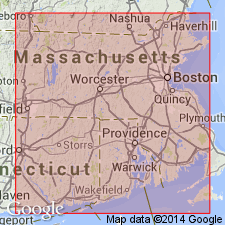
- Usage in publication:
-
- Conanicut Group
- Modifications:
-
- Original reference
- Biostratigraphic dating
- Dominant lithology:
-
- Phyllite
- Siltstone
- AAPG geologic province:
-
- New England province
Summary:
Pg. 21-22 (table 2), 32-35. Conanicut Group. Metasedimentary sequence of dark phyllites and salmon-colored siltstones exposed in the Esmond-Dedham subterrane (Avalon terrane), on Conanicut Island, southern Narragansett Bay, southeastern Rhode Island. Divided into (descending): Dutch Island Harbor Formation, 100 m thick; Fort Burnside Formation, 30 m thick; and Jamestown Formation, 200 m thick. Lies above Pirate Cave Formation. The basal Jamestown may be equivalent to the East Passage Formation of the northwestern shores of Newport Neck. [East Passage Formation later included in Conanicut Group; see geologic map of Rhode Island (Hermes and others, 1994).] Fossils (trilobites, acritarchs). Age is considered Middle Cambrian(?) to Early Ordovician(?), based on fossils.
Named from the exposures in seacliffs on Conanicut Island, southern Narragansett Bay, southeastern RI.
Source: Publication.
For more information, please contact Nancy Stamm, Geologic Names Committee Secretary.
Asterisk (*) indicates published by U.S. Geological Survey authors.
"No current usage" (†) implies that a name has been abandoned or has fallen into disuse. Former usage and, if known, replacement name given in parentheses ( ).
Slash (/) indicates name conflicts with nomenclatural guidelines (CSN, 1933; ACSN, 1961, 1970; NACSN, 1983, 2005, 2021). May be explained within brackets ([ ]).

